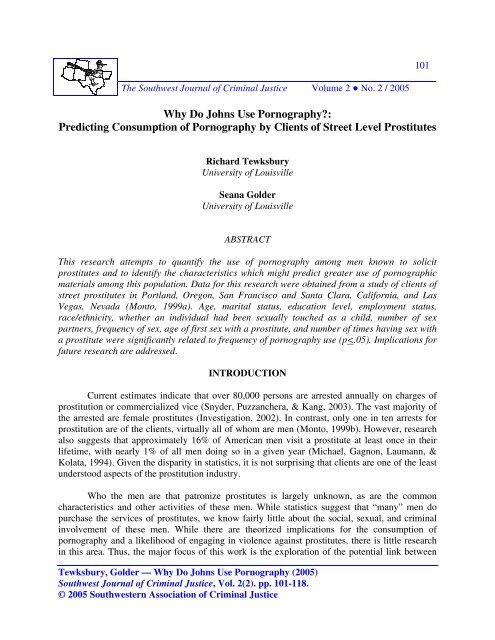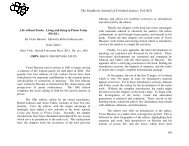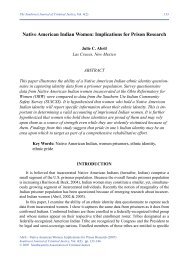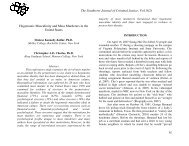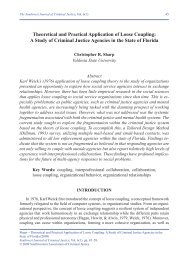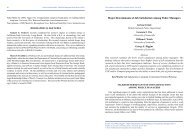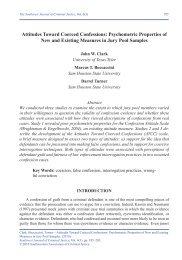Why Do Johns Use Pornography?: Predicting Consumption of ...
Why Do Johns Use Pornography?: Predicting Consumption of ...
Why Do Johns Use Pornography?: Predicting Consumption of ...
Create successful ePaper yourself
Turn your PDF publications into a flip-book with our unique Google optimized e-Paper software.
The Southwest Journal <strong>of</strong> Criminal Justice, Vol. 2(2) 107physically hurt as children. Additionally, one-quarter (24.9%) <strong>of</strong> the respondents reported eithercurrently or in the past having served in the military.General Sexual BehaviorThe vast majority <strong>of</strong> respondents (90%) identified as exclusively heterosexual. Given thelack <strong>of</strong> variability in sexual orientation, this variable was excluded from further analysis. Mostfrequently, respondents reported having one (36.8%) or two (16.4%) sexual partners in the last12 months. Slightly more than 20% <strong>of</strong> respondents reported having sex two or three times amonth during the past 12 months, although approximately 18% and 17%, respectively, reportedhaving sex either once a week or two or three times a week. Approximately 40% <strong>of</strong> therespondents indicated that they had not had sex with a prostitute in the past twelve months. Mostcommonly (48%), men reported that they had either had sex with a prostitute only one time, ormore than one time, but less than once per month in the past year.Sexually Aggressive BehaviorAn extremely low frequency <strong>of</strong> reported use <strong>of</strong> threats or actual violence for purposes <strong>of</strong>obtaining sex was reported. Only 14 and 11 respondents, respectively, indicated that they hadused either threats <strong>of</strong> or actual violence to get sex (eight respondents replied they had used both).Consequently, as with sexual orientation, questions assessing whether a respondent had usedthreats <strong>of</strong> or actual violence to get sex were excluded from further analysis due to lack <strong>of</strong>variability. Additionally, there was very little endorsement <strong>of</strong> rape myths within the sample (seeMonto & Hotaling, 2001).Frequency <strong>of</strong> <strong>Pornography</strong> <strong>Use</strong>Twenty five percent <strong>of</strong> the sample reported never using pornography, and approximately90% <strong>of</strong> the respondents who did report using pornography claimed to do so less than once amonth.Exploratory AnalysisThe analysis was conducted in two steps. In the first step, regression analysis was used toexamine the relationship among all the hypothesized predictors (e.g., demographiccharacteristics, personal background characteristics, general sexual behavior, and the Rape MythAcceptance Scale), and the dependent variable, frequency <strong>of</strong> pornography use. Categoricalvariables were dummy coded. For marital status, individuals who reported being married weretreated as the comparison group (group assigned zero’s throughout). White was the comparisongroup for race/ethnicity. The comparison group for education level was having a high schooldiploma or less. Not working full or part-time was the comparison group for employment status.All the predictors were entered into the equation simultaneously.
Tewksbury, Golder – <strong>Why</strong> <strong>Do</strong> <strong>Johns</strong> <strong>Use</strong> <strong>Pornography</strong> – (2005) 108Table 2 displays the regression coefficients for the model. Overall, the variables in themodel explained 14% <strong>of</strong> the variance in pornography use. Age, whether an individual had beensexually touched as a child, number <strong>of</strong> sex partners during the last 12 months, frequency <strong>of</strong> sexduring the last 12 months, age <strong>of</strong> first sex with a prostitute, and number <strong>of</strong> times reported havingsex with a prostitute during the last 12 months, were significantly related to frequency <strong>of</strong>pornography use (p
The Southwest Journal <strong>of</strong> Criminal Justice, Vol. 2(2) 109for participants that reported never being married, Asian, having some college, and a Bachelor’sor Master’s degree, respectively).Given that significant results were found for group membership, as defined by maritalstatus, race/ethnicity, educational level, and employment status, respectively, the second step <strong>of</strong>the analysis involved further examination <strong>of</strong> the relationship between group membership andfrequency <strong>of</strong> pornography use. As in the first step <strong>of</strong> the analysis, a series <strong>of</strong> regressions wereconducted to examine the relationship among the hypothesized predictors and frequency <strong>of</strong>pornography use - defined by group membership. To have the most parsimonious modelspossible, variables that failed to yield a significant relationship with frequency <strong>of</strong> pornographyuse in the first step <strong>of</strong> the analysis were excluded from subsequent models. The removal <strong>of</strong> thesevariables did not change the pattern <strong>of</strong> estimated coefficients. Results <strong>of</strong> these regressions as wellas the average frequency <strong>of</strong> pornography use (as described above, frequency <strong>of</strong> pornography usewas measured on a 0 [never] to 5 [several times a day scale]) for each subgroup are presented inTable 3.Table 3.Relationship among the hypothesized predictors and frequency <strong>of</strong> pornography use -defined by group membership.VariableMarital statusMarried (n=560) Divorced (n=304) Never Married (n=464)Mean Freq. <strong>of</strong> Porn. <strong>Use</strong> .945 1.029 1.195b SE Beta b SE Beta b SE BetaAge -.004 .003 -.049 -.014* .005 -.161 -.007 .006 -.061Touched Sexually .036 .106 .014 .300* .146 .114 .334* .137 .113# <strong>of</strong> Sex Partners .015 .028 .031 .016 .036 .035 .094* .028 .186Freq. <strong>of</strong> Sex .068* .023 .132 .023 .034 .045 .021 .027 .040Age Sex w/Prost. .065* .028 .105 .070 .039 .105 .071 .045 .082# <strong>of</strong> Times w/Prost. .115* .043 .155 .176* .054 .230 .068 .048 .078
Tewksbury, Golder – <strong>Why</strong> <strong>Do</strong> <strong>Johns</strong> <strong>Use</strong> <strong>Pornography</strong> – (2005) 110Table 3.Relationship among the hypothesized predictors and frequency <strong>of</strong> pornography use -defined by group membership.VariableEducation LevelHS Diploma or Less(n=384)Some College(n=482)Bachelor’s or Master’s(n=463)Mean Freq. <strong>of</strong> Porn. <strong>Use</strong> .833 1.109 1.173b SE Beta b SE Beta b SE BetaAge -.005 .004 -.073 -.015* .004 -.190 -.012* .004 -.138Touched Sexually .133 .137 .049 .179 .115 .069 .291* .125 .108# <strong>of</strong> Sex Partners .055 .028 .116 .058* .028 .118 .017 .029 .037Freq. <strong>of</strong> Sex .053* .024 .120 .041 .026 .076 -.014 .028 -.025Age Sex w/Prost. .098* .036 .143 .080* .037 .109 .007 .033 .010# <strong>of</strong> Times w/Prost. .093 .048 .113 .080 .046 .100 .171* .046 .225VariableEmployment StatusNot Employed Employed (n=1132)(n=170)Mean Freq. <strong>of</strong> Porn. <strong>Use</strong> 1.130 1.039b SE Beta b SE BetaAge -.010* .003 -.113 -.015* .004 -.245Touched Sexually .136 .079 .051 .647* .209 .224# <strong>of</strong> Sex Partners .046* .018 .095 .117* .045 .236Freq. <strong>of</strong> Sex .050* .017 .096 -.046 .043 -.088Age Sex w/Prost. .079* .023 .111 .017 .053 .024# <strong>of</strong> Times w/Prost. .091* .030 .113 .152* .068 .188* Significant at p< .05 with value equal to or greater than 1.96.
The Southwest Journal <strong>of</strong> Criminal Justice, Vol. 2(2) 111Table 3.Relationship among the hypothesized predictors and frequency <strong>of</strong> pornography use -defined by group membership.VariableMean Freq. <strong>of</strong><strong>Pornography</strong> <strong>Use</strong>Race/EthnicityWhite(n=757)African American(n=68)Hispanic(n=264)1.082 1.086 .871b SE Beta b SE Beta b SE BetaAge -.012* .003 -.147 .000 .010 .003 -.001 .007 -.013Touched Sexually .147 .095 .055 .179 .282 .078 .380* .181 .131# <strong>of</strong> Sex Partners .051* .022 .110 -.116 .068 -.252 .071 .037 .135Freq. <strong>of</strong> Sex .029 .021 .054 .077 .063 .157 .062 .032 .129Age Sex w/Prost. .054* .025 .082 .003 .086 .004 .037 .060 .040# <strong>of</strong> Times w/Prost. .086* .035 .113 .256* .100 .348 .099 .068 .102VariableMean Freq. <strong>of</strong><strong>Pornography</strong> <strong>Use</strong>Race/EthnicityAsianOther(n=167)(n=57)1.264 .858b SE b SE b SEAge -.024* .006 -.024* .006 -.024* .006Touched Sexually .274 .194 .274 .194 .274 .194# <strong>of</strong> Sex Partners .106* .050 .106* .050 .106* .050Freq. <strong>of</strong> Sex -.042 .049 -.042 .049 -.042 .049Age Sex w/Prost. .091 .059 .091 .059 .091 .059# <strong>of</strong> Times w/Prost. .090 .082 .090 .082 .090 .082The first step in the analysis indicated that respondents who reported never being marriedwere more frequent users <strong>of</strong> pornography than those who reported being married. Examination <strong>of</strong>the regression coefficients for never married respondents in step 2 indicates that being touchedsexually as a child and the number <strong>of</strong> sex partners in the past 12 months are significantly relatedto frequency <strong>of</strong> pornography use among this subgroup <strong>of</strong> men. Significant differences (in step 1)were also found between respondents who had some college or a bachelor’s or master’s degreeand those with a high school diploma or less. Analysis revealed that age is inversely related t<strong>of</strong>requency <strong>of</strong> pornography use for both men with some college and those with a bachelor’s ormaster’s degree. In addition to age, number <strong>of</strong> sex partners and reported age when they first hadsex with a prostitute are significantly related to frequency <strong>of</strong> pornography use among men with
Tewksbury, Golder – <strong>Why</strong> <strong>Do</strong> <strong>Johns</strong> <strong>Use</strong> <strong>Pornography</strong> – (2005) 112some college. Among men with bachelor’s or master’s degrees, being touched sexually as a childand the number <strong>of</strong> times they have been with a prostitute are significant predictors <strong>of</strong>pornography use.There were also significant differences in pornography use between respondents based onemployment status. With the exception <strong>of</strong> being touched sexually, all the predictors weresignificantly related to pornography use for men who reported not being employed full or parttime.For men who were employed, frequency <strong>of</strong> sex and age they first reported having sex witha prostitute failed to yield a significant relationship with frequency <strong>of</strong> pornography use.Finally, in regards to race/ethnicity, the initial regression model indicated that there was asignificant difference in frequency <strong>of</strong> pornography use between white and Asian men, with Asianmen having a higher frequency <strong>of</strong> pornography use than men in any other racial/ethnic group.Examination <strong>of</strong> the regression coefficients in Table 3 indicates that only age and number <strong>of</strong> sexpartners were significantly related to pornography use among Asian respondents; age wasinversely related to pornography use.DISCUSSIONGiven the dearth <strong>of</strong> information regarding the male clients <strong>of</strong> female prostitutes, thisstudy was exploratory. In particular, we sought to explore the potential link between patronizingprostitutes, consuming pornography, and sexually violent activities. Results indicated thatsexually aggressive behaviors among this sample were infrequent. Thus, within this sample, norelationship was found between patronizing prostitutes, consuming pornography, and sexualviolence.Somewhat surprisingly, in contrast to prior work and our own predictions, the Rape MythAcceptance Scale failed to reach significance (i.e., there was no relationship betweenparticipants’ belief in rape myths and pornography use). A number <strong>of</strong> methodological issues mayhave affected this particular finding. As stated above, this sample was generally well educated,with over 70% reporting they had at least some college. The respondents, who already fall into astigmatized category (e.g. arrested johns), may have “seen through” the questions comprising theRape Myth Acceptance Scale, and responded in what they thought was a more sociallyacceptable, less stigmatized way. Thus, biased responses may have attenuated any relationshipbetween the Rape Myth Acceptance Scale and frequency <strong>of</strong> pornography use.Furthermore, although the Rape Myth Acceptance Scale was comprised <strong>of</strong> multiple itemsand measured at the interval level, both the other measures <strong>of</strong> sexual aggression were singleitems with dichotomous response options. Examination <strong>of</strong> the results indicated that there was arelatively low frequency <strong>of</strong> affirmative responses to these questions and they were subsequentlydropped from further analyses. It may be that measures that are comprised <strong>of</strong> multiple items, thatsurvey a range <strong>of</strong> sexually threatening and violent behaviors, and record responses on a moresensitive scale (i.e. interval level) may be more appropriate tools for assessing engagement insexually aggressive behavior. Notwithstanding, it is quite possible that among this particular
The Southwest Journal <strong>of</strong> Criminal Justice, Vol. 2(2) 113population that there is relatively little relationship between pornography use and sexualaggression. Further research employing more sensitive measures <strong>of</strong> sexual aggression is neededto better understand the relationship between sexual aggression and pornography use amongmale customers <strong>of</strong> female prostitutes.Relatedly, there are many different types <strong>of</strong> pornography. The variables assessingfrequency <strong>of</strong> pornography use in the study from which these data were taken did not specify thecontent <strong>of</strong> the pornographic material (e.g., depictions <strong>of</strong> forced sexual acts or more consensualinteractions). It is likely that there is significant variability among the sample in terms <strong>of</strong> theirpreference in regards to the content, as well as delivery method (e.g., video, magazine, internet,peep show, etc.) <strong>of</strong> pornographic material. Future studies incorporating more sensitive measures<strong>of</strong> pornography use and variety may allow us to identify subgroups <strong>of</strong> pornography users anddifferential predictors associated with these subgroups. For example, it may be that moresexually aggressive men prefer pornography that depicts violence (Seto et al., 2001).In addition to the focus on pornography and violence, we sought to develop a greaterunderstanding <strong>of</strong> the demographic and personal background characteristics, as well as the nonviolentsexual activities among the male clients <strong>of</strong> street level prostitutes. To this effect, ouranalysis identified 10 variables that collectively account for 14% <strong>of</strong> the variance associated withfrequency <strong>of</strong> pornography use among this sample <strong>of</strong> street prostitutes’ clients. The variables thatwere significant predictors <strong>of</strong> frequency <strong>of</strong> pornography use include all five <strong>of</strong> the testeddemographics, one <strong>of</strong> four personal background traits (whether an individual had been sexuallytouched as a child), and four <strong>of</strong> the five assessed general sexual behavior variables (number <strong>of</strong>sex partners during the last 12 months, frequency <strong>of</strong> sex during the last 12 months, age <strong>of</strong> firstsex with a prostitute, and number <strong>of</strong> times reported having sex with a prostitute during the last 12months). The results indicated that age, the number <strong>of</strong> times respondents reported having sexwith a prostitute during the last 12 months, and educational level were associated with the largestincreases in frequency <strong>of</strong> pornography use. Thus, men who had sex more frequently withprostitutes, who were more educated, and who were younger, were more frequent users <strong>of</strong>pornography than other men in the sample.Significant subgroup differences defined by demographic categories were also found tobe important correlates <strong>of</strong> frequency <strong>of</strong> pornography use. Never married men were more frequentusers <strong>of</strong> pornography than their married counterparts, as were men with higher levels <strong>of</strong>education. Respondents who reported being unemployed were more frequent consumers <strong>of</strong>pornography, as were Asian men. It is also important to point out that whether a respondent wastouched sexually as a child consistently appears to play a significant role in frequency <strong>of</strong>pornography use for some groups <strong>of</strong> men (divorced and never married men, men with collegedegrees and employed men). Clearly, having been sexually abused as a child plays a role infrequency <strong>of</strong> pornography consumption; however, further research is needed to fully understandthis relationship.Several limitations <strong>of</strong> the present work should be acknowledged. Although participationwas voluntary and the participation rate was 80%, participants were men arrested for soliciting
Tewksbury, Golder – <strong>Why</strong> <strong>Do</strong> <strong>Johns</strong> <strong>Use</strong> <strong>Pornography</strong> – (2005) 114female prostitutes and participating in deferred adjudication programs (Monto, 1999a, 1999b).As noted in Busch et al. (2002), “their attitudes may not be representative <strong>of</strong> male customers as awhole. [Moreover,] the connection between attitudes and behaviors is not direct” (pg. 1109).Although not a universally accepted position, a large body <strong>of</strong> research supports the reliability andvalidity <strong>of</strong> self-report data (e.g. Darke, 1998; Hindeland, Hirschi, & Weis, 1981; Hser, 1993;Lauritsen, 1998; Rouse, Kozel, & Richards, 1985). It is important to note that the study fromwhich these data were drawn relies heavily on respondents’ self-reports <strong>of</strong> socially undesirablebehaviors. Care should be taken in interpreting and generalizing these results as the sample maynot be fully representative <strong>of</strong> the population <strong>of</strong> clients <strong>of</strong> street prostitutes. Finally, it should beacknowledged that this study examines correlates <strong>of</strong> behaviors. The time ordering <strong>of</strong> activitiescan not be deduced from the data. Many <strong>of</strong> the predictors <strong>of</strong> pornography use could haveoccurred contemporaneously to or after the use <strong>of</strong> pornography. Care must therefore be exercisedin interpreting findings.It should be noted that a particular strength <strong>of</strong> the current study is our handling <strong>of</strong> missingdata. Prior published research utilizing these data has either failed to address this issue or usedmean substitution. This suggests that conclusions based on prior analyses may be significantlybiased (Choi et al., 2005; Graham et al., 1997; Graham et al., 1994). The current study imputedmissing data via a raw maximum-likelihood procedure allowing us to obtain unbiased parameterestimates and reasonable standard errors (Choi et al., 2005; Muthen & Muthen, 2000). Thus,conclusions based on the analyses reported here are done without the threats present in priorstudies with this data.In conclusion, this was an exploratory study that sought to increase our understanding <strong>of</strong>behavior among an understudied population: male customers <strong>of</strong> female, street level prostitutes.Results <strong>of</strong> this research suggest that although pornography use may not be rampant among thispopulation, there are demographic, personal background, and general sexual behavior variablesthat are predictive <strong>of</strong> pornography consumption. These results also call into question the veracity<strong>of</strong> feminist claims regarding connections between pornography consumption, objectification <strong>of</strong>women, and violence against women. Men who patronize street-level prostitutes are notespecially likely to be frequent consumers <strong>of</strong> pornography.
The Southwest Journal <strong>of</strong> Criminal Justice, Vol. 2(2) 115REFERENCESArmstrong, E. G. 1978. “Massage Parlors and Their Customers.” Archives <strong>of</strong> Sexual Behavior,Volume 2, pp. 117-125.Atchison, Chris, Fraser, Laura, & Lowman, John. 1998. “Men Who Buy Sex: PreliminaryFindings <strong>of</strong> an Exploratory Study” in G. Brewer (Ed.), Prostitution: On whores, hustlers, andjohns. Amherst, NY: Prometheus: pp. 172-203.Burt, M. 1980. “Cultural Myths and Supports for Rape.” Journal <strong>of</strong> Personality and SocialPsychology, Volume 38, pp. 217-230.Busch, N., Bell, H., Hotaling, N., & Monto, M. 2002. “Male Customers <strong>of</strong> Prostituted Women:Exploring Perceptions <strong>of</strong> Entitlement to Power and Control and Implications for ViolentBehavior Toward Women. Violence Against Women, Volume 8(9), pp. 1093-1112.Choi, Yoonsun, Golder, Seana, Gillmore, Mary Rogers, & Morrison, Diane. 2005. “Analysiswith Missing Data in Social Work Research.” Journal <strong>of</strong> Social Work Research, Volume 31 (3),pp. 23-48.Darke, S. 1998. “Self-Report among Injecting Drug <strong>Use</strong>rs: A Review.” Drug and AlcoholDependence, Volume 51, pp. 253-263.Davis, N. 1993. Prostitutions: An International Handbook on Trends, Problems, and Policies.London: Greenwood.Diana, L. 1985. The Prostitute and Her Clients: Your Pleasure is Her Business. Springfield, IL:Charles C. Thomas.Farley, M., & Barkan, H. 1998. “Prostitution, Violence against Women, and Posttraumatic StressDisorder. Women & Health, Volume 27(3), pp. 37-49.Federal Bureau <strong>of</strong> Investigation 2002. Uniform Crime Reports: Crime in the Unites States - Ten-Year Arrest Trends by Sex, 1993-2002. Washington D.C.: Federal Bureau <strong>of</strong> Investigation.Graham, J. W., H<strong>of</strong>er, S. M., <strong>Do</strong>naldson, S. I., Mackinnon, D. P., & Schafer, J. L. 1997.“Analysis with Missing Data in Prevention Research” in S. West (Ed.), The Science <strong>of</strong>Prevention: Methodological Advances from Alcohol and Substance Abuse Research. WashingtonD.C.: American Psychological Association: pp. 325-366.Graham, J. W., H<strong>of</strong>er, S. M., & Piccinin, A. M. 1994. “Analysis with Missing Data in DrugPrevention Research” in L. Seitz (Ed.), Advances in Data Analysis for Prevention InterventionResearch. Washington D.C.: National Institute on Drug Abuse: pp. 13-63.
Tewksbury, Golder – <strong>Why</strong> <strong>Do</strong> <strong>Johns</strong> <strong>Use</strong> <strong>Pornography</strong> – (2005) 116Hindeland, M. J., Hirschi, T., & Weis, J. 1981. Measuring Delinquency. Beverly Hills, CA: SagePublications.Holzman, H. R., & Pines, S. 1982. “Buying Sex: The Phenomenology <strong>of</strong> Being a John.” DeviantBehavior, Volume 49, pp. 89-116.Horgard, C., & Finstad, L. 1992. Back Streets: Prostitution, Money and Love. University Park,PA: Pennsylvania State University Press.Hser, Y.-I. 1993. “Data Sources: Problems and Issues.” Journal <strong>of</strong> Drug Issues, Volume 23(4),pp. 217-229.Lauritsen, Janet. 1998. “The Age-Crime Debate: Assessing the Limits <strong>of</strong> Longitudinal Self-Report Data.” Social Forces, Volume 77(1), pp. 127-154.McKegany, N., & Barnard, M. 1996. Sex Work on the Streets: Prostitutes and Their Clients.Buckingham, UK: Open University Press.Michael, R., Gagnon, J., Laumann, E., & Kolata, G. 1994. Sex in America. Boston: Little, Brownand Company.Miller, Jody. 1993. “Your Life Is on the Line Every Night You're on the Streets: Victimizationand Resistance among Street Prostitutes.” Humanity and Society, Volume 17(4), pp. 422-446.Miller, Jody & Schwartz, Martin. 1995. “Rape Myths and Violence Against Street Prostitutes.”Deviant Behavior, Volume 16(1), pp. 1-23.Monto, Martin. 1999a. Clients <strong>of</strong> Street Prostitutes in Portland, Oregon, San Francisco, andSanata Clara, California, and Las Vegas, Nevada, 1996-1999 [Computer file]. (Ann Arbor, MI:Inter-university Consortium for Political and Social Research [distributor], 2000 ed.): Portland,OR: University <strong>of</strong> Portland [producer].Monto, Martin. 1999b. Focusing on the Clients <strong>of</strong> Street Prostitutes: A Creative Approach toReducing Violence Against Women - Summary Report (182859). Washington, D.C.: U.S.Department <strong>of</strong> Justice.Monto, Martin. 2000. “<strong>Why</strong> Men Seek Out Prostitutes” in R. Weitzer (Ed.), Sex for Sale:Prostitution, <strong>Pornography</strong> and the Sex Industry. New York: Routledge: pp. 67-83Monto, Martin. 2001. “Prostitution and Fellatio.” The Journal <strong>of</strong> Sex Research, Volume 38(2),pp. 140-145.Monto, Martin, & Hotaling, Norma. 2001. “Predictors <strong>of</strong> Rape Myth Acceptance among MaleClients <strong>of</strong> Female Street Prostitutes.” Violence Against Women, Volume 7(3), pp. 275-293.
The Southwest Journal <strong>of</strong> Criminal Justice, Vol. 2(2) 117Muthen, L., & Muthen, B. 2000. Mplus: The Comprehensive Modeling Program for AppliedResearchers. <strong>Use</strong>r's Guide Version 2.0. Los Angeles, CA: Muthen & Muthen.Rouse, B., Kozel, N., & Richards, L. 1985. Self-Report Methods <strong>of</strong> Estimating Drug <strong>Use</strong> -Meeting Current Challenges to Validity (NIDA Research Monograph 57): National Institute <strong>of</strong>Drug Abuse.Sawyer, S., Rosser, B. R. S., & Schroeder, A. 1998. “Brief Psychoeducational Program for MenWho Patronize Prostitutes.” Journal <strong>of</strong> Offender Rehabilitation, Volume 26(3), pp. 111-125.Seto, M., Maric, A., & Barbaree, H. 2001. The Role <strong>of</strong> <strong>Pornography</strong> in the Etiology <strong>of</strong> SexualAggression.” Aggression and Violent Behavior, Volume 6, pp. 35-53.Silbert, M. 1988. “Compounding Factors in the Rape <strong>of</strong> Street Prostitutes. In A. Burgess (Ed.),Rape and sexual assault, II. New York: Garland Press: pp. 75-90.Snyder, H., Puzzanchera, C., & Kang, W. 2003. Easy Access to FBI Arrest Statistics 1994-2001[Online]. Retrieved 04/14/04, 2004, from the World Wide Web:http://ojjdp.ncjrs.org/ojstatbb/ezaucr/Sullivan, Elroy, & Simon, William. 1998. “The Client: A Social, Psychological and BehavioralLook at the Unseen Patron <strong>of</strong> Prostitution.” In G. Brewer (Ed.), Prostitution: On whores,hustlers, and johns. Amherst, NY: Prometheus: pp. 134-154.Tewksbury, Richard, & Adkins, Mark. 1992. Rape Myths and Emergency Room Personnel.Response to the Victimization <strong>of</strong> Women and Children, Volume 14(4), pp. 10-15.Winick, Charles. 1962. “Prostitutes' Clients' Perceptions <strong>of</strong> the Prostitutes and Themselves.”International Journal <strong>of</strong> Social Psychiatry, Volume 8(4), pp. 289-299.
Tewksbury, Golder – <strong>Why</strong> <strong>Do</strong> <strong>Johns</strong> <strong>Use</strong> <strong>Pornography</strong> – (2005) 118BIOGRAPHICAL SKETCHESRichard Tewksbury is a Pr<strong>of</strong>essor in the Department <strong>of</strong> Justice Administration at the University<strong>of</strong> Louisville. He holds degrees in sociology from The Ohio State University. He is primarilyinterested in issues <strong>of</strong> deviant behavior (crime, drug use/abuse, sexuality), men's studies andqualitative methods. He is actively involved in a variety <strong>of</strong> research and service projects workingwith correctional departments and institutions, police departments, and social service agencies.Seana Golder is an Assistant Pr<strong>of</strong>essor in the Kent School <strong>of</strong> Social Work at the University <strong>of</strong>Louisville. She received her M.S.W from Louisiana State University and her Ph.D. in SocialWelfare from the University <strong>of</strong> Washington. Her primary research interests are around the issues<strong>of</strong> women’s risk behavior (e.g., substance use, sexual risk, and lawbreaking) and involvement inthe criminal justice system.


